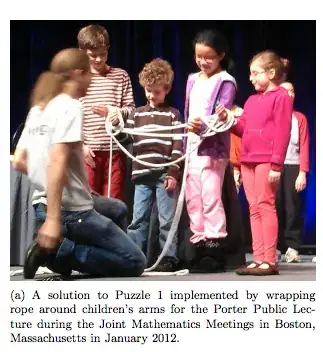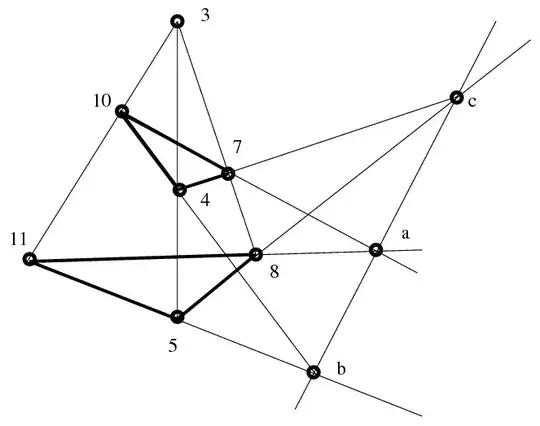I am trying to prepare a "mathematics talk" for five year olds from my daughter's elementary school. I have given many mathematics talks in my life but this one feels very tough to prepare. Could the members of the community share their experience with these kind of lectures. I was thinking to talk about some theorems of Euclidean geometry which will include some old fashion compass, straight edge construction with some kind "magical outcome" and then try to give kids some logical reasons for the "magic". Any ideas?
Edit: I would like to thank one more time to the members of the mathoverflow community for their generous input and support as well to report the outcome of my talk.
I just got out from my daughter's elementary school where I ended up teaching four class periods today instead of the one I originally prepared for. I taught two sections of 5 year olds (26 kids a section) as well as two large group of fifth graders (close to 100 kids in total). I was "over prepared" to talk to 5 year olds which came handy with fifth graders.
Inspired by the answers from this forum I chose to talk about Platonic solids and have kids mostly engaged in practical activities as oppose of "teaching" them. My assistant chair at Augusta State University Georgia has generously shared her large collection of POLYDRON blocks. I had three bags full of equilateral triangles, squares, and pentagons. I have also pre-build one set of all five Platonic solids (Tetrahedron, Cube, Octahedron, Dodecahedron, and Icosahedron). I have also printed out cut and fold maps for all solids from this website and gave them to kids together with building blocks.
We identified first the properties of polygons (number of sides, vertices, and angles) of each of building blocks were to use as well as the fact they were regular (sides and angles of equal length). I was rather surprised that five year old children have no problem identifying pentagon as it is the shape of rather important building in Washington DC.
Then we introduced the rules of our "game":
Only the same "shapes" were to be used for building solids.
Two faces could meet only in one edge.
Each vertex of the solid had to meet the same number of faces.
Five year old kids had no problem assembling Tetrahedron, Cube, Octahedron however not a single group (they were allowed to work alone of in groups of 2-3) was able to assemble Dodecahedron, and Icosahedron. This was not the case with fifth graders (older kids) where several groups (4-5 out of 100 kids) successfully assembled Dodecahedron, and Icosahedron.
Even 5 year olds were able to identify number of faces, edges, and vertices by counting from the cut and fold charts. They had harder time identifying Schläfli symbols for each Platonic surface due to the fact that they had to count them on my pre-build models but they have never the less accomplished the task. We were able to come up with Euler characteristic (magic number as I referred) but the real focus was on subtracting numbers which we did using our fingers. Obviously the kids got lost after the cube due to the size of numbers involved. I was not able to convey any information about further combinatorial properties of Platonic solids related to Schläfli symbols to five year olds.
On another hand fifth graders had no problems identifying
$$pF=2E=qV$$
but had hard time solving equations as $pF=2E$ for $F$ and $2E=qV$ for $V$ and substituting into
$$V-E+F=2$$
not a single fifth grader could follow my computation for the estimate
$$\frac{1}{p}+\frac{1}{q}>\frac{1}{2}$$
where were effectively ended our little lecture.
In both sections kids asked me to preform some more "magic tricks". I glued a long strip of paper for them creating a cylinder and Mobius bend. Many kids thought of cylinder as a circle and Mobius bend as a figure eight (few fifth graders mentioned infinity symbols) even that they could not give any logical explanation why they think that way. We cut cylinder and Mobius bend and children start cheering my name when Mobius bend "broke" into just another bigger Mobius bend.
Five year olds wanted to hug me after the lecture and sit at my table in cafeteria. The fifth graders were either indifferent or came to me after the talk to shake my hand and ask if I can teach another class. It is also worth noting that while playing with blocks many fifth graders made prisms, pyramids while some try to pass non-platonic solids for Platonic solids bending rules of our game.
Teachers were trusty for this kind of experience. They are in a bad need for professional development after years of budget cuts and fear for their jobs. The school is going to buy blocks. I hope to make visits semi-regular and help them as much as I can (obviously out of selfish interest to improve my daughter's education). I have already planed to introduce some other games like tangram, pentominoes, and Hanoi tower. I will also install GeoGebra on their computers.
I might edit this post in next few days and add few details.
Most Kind Regards,
Predrag



Even the slowest ones enjoyed the models and the colors. hjere are some more links:
http://mathoverflow.net/questions/47214/how-to-present-mathematics-to-non-mathematicians/47256#47256
http://www.maths.liv.ac.uk/lms/funmaths/
– roy smith Oct 03 '12 at 16:34